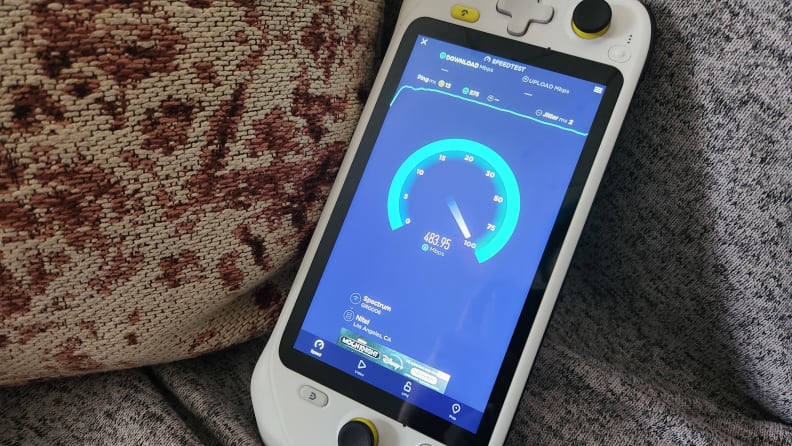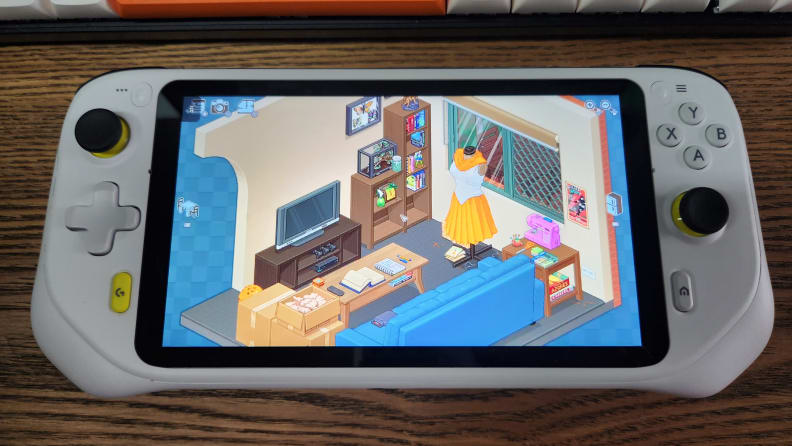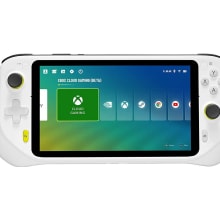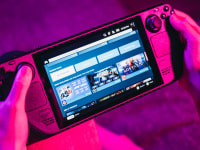Pros
-
Super comfortable
-
Incredible battery life
-
Great display and performance
Cons
-
Wi-Fi reliance reduces portability
With the G Cloud’s reliable and fast internet connection, you won’t be able to tell the difference between playing games in the cloud and on a local device. It’s more comfortable to hold than the Steam Deck, its battery life is two to three times longer than other major handheld consoles, and it runs on Android so it’s also a fully functional tablet. It's truly one of my favorite handhelds.
About the Logitech G Cloud Gaming Handheld
- Processor: Qualcomm Snapdragon 720G (SD720G) Octa-Core up to 2.3GHz
- Memory: 64GB ROM
- Display: 7-inch 1920 x 1080 FHD 16:9 ratio, IPS LCD, 450 nits, 60Hz, Touchscreen
-
Connectivity: Bluetooth 5.1, 3.5mm headset jack, USB-C, MicroSD
-
Battery: 23.1 watt-hours, 12+ hours of gameplay
- Dimensions: 10.11 x 4.61 x 1.30 inches
- Weight: 16.3 ounces
- Warranty: 1-year limited
The Logitech G runs on Android OS and comes with Nvidia GeForce Now, Xbox Cloud Gaming, and a host of Google apps preinstalled. (It can run Google Stadia too, but Stadia won’t be around much longer.)
The console also functions as a regular Android tablet, as it has a touch screen, and anything you can download from the Google Play Store can be installed on this device. This console normally costs $350, but if you pre-order from Logitech or Amazon before 10/17 you can get it for $300.
What we like
Great performance over 5GHz Wi-Fi and 5G

The Logitech G supports up to Gigabit Wi-Fi speeds (WiFi 5).
When the Logitech G has access to a large amount of bandwidth (50Mbps or more) playing games on it feels like playing a game downloaded to the Steam Deck or any other handheld console. Response times are quick and snappy. Movement is smooth and precise. Loading times are also fast.
Competitive players should stick with playing games the traditional way (on a local machine) because there is always less latency compared to cloud gaming. But for the casual player, even if you game 10-20 hours a week, the performance is indistinguishable from playing locally on the Steam Deck, Xbox, or even a PC.
Incredible battery life
Logitech’s new console boasts 12-plus hours of battery life, depending on how often you play, screen brightness, and a variety of other factors that differ from gamer to gamer. That’s much longer than the Nintendo Switch (4.5 to nine hours), Nintendo Switch Lite (three to seven hours), and the Valve Steam Deck (two to four hours).
I spent a week using the Logitech G, playing a range of games with varying levels of graphical fidelity like Stardew Valley, Dragon Age Inquisition, Cyberpunk 2077, Banjo Kazooie, Death Stranding, Escape Academy, and Powerwash Simulator, and after about 4-5 hours of playtime, the battery was only at 50%.
I was playing at a 1080p resolution with the graphics cranked to their maximum preset, too. (You can only do this with Nvidia GeForce Now, not Xbox’s cloud gaming service.) It’s truly remarkable to see how just how much more battery life you can get from a gaming device by only playing games in the cloud.
Large 1080p display
I’m not even mad the Logitech G doesn’t have an OLED display, because every game I tried on it looks stunning. The colors pop. The black levels don’t have a gray haze over them, so the contrast looks great. It also has a larger display resolution than the Steam Deck (1280 x 800) and all of the Nintendo Switch models (1280 x 720).
The Logitech G’s display is much larger than your standard Android or iPhone display, which is great for playing games like Dragon Age Inquisition, Cyberpunk 2077, and others that have small or squished UI text over mobile. It’s just good enough so people like me who wear glasses can actually see the words on the screen, and even have an easier time picking out enemy NPCs from far away.
Super comfortable to hold

The 7-inch screen is just large enough to make the UI text in certain games like Dragon Age Inquisition easier to read.
For all my raving about how awesome Valve’s Steam Deck is to hold, Logitech steps up the comfort factor by a noticeable amount. Even though both have the same display size, the Logitech G console is an inch shorter than the Steam Deck and weighs 16.3 ounces compared to the Deck’s 23.5 ounces.
The ends also have larger, rounded grips that conform to my small palms, and they are textured to help maintain your grip. The Steam Deck’s hand grips are not textured, and all the Nintendo Switch models don’t even have ergonomic hand grips, which causes my fingers to seize up after playing for longer periods of time. I did not have that issue with the Logitech G. My hands and fingers felt as refreshed after hours of playtime as they did when I first picked up the console.
My one, tiny complaint is the Logitech G’s button layout. Yes, it’s a standard Xbox layout, but I prefer how Valve put the thumbsticks directly to the side of the D-Pad and ABXY buttons. I have short thumbs, so the Steam Deck’s layout allows me to move from the thumbsticks to the D-Pad/ABXY buttons without shifting my grip on the console itself.
That’s not the case with the Logitech G, but even though I do have to shift my grip slightly from the thumbsticks to the buttons, it doesn’t change how comfortable it is.
What we don’t like
No Wi-Fi makes it literally half as useful
Without internet access to connect you with the cloud gaming platform of your choice, the Logitech G becomes a fancy-looking brick. Yes, you can go into tablet mode and access games you’ve downloaded and installed directly on the storage drive, but the number of PC and console games that have been ported to Android is not nearly as robust as everything that’s available through GeForce Now or Xbox Game Pass.
There’s also an extremely limited amount of physical storage space in the Logitech G—64GB. Games like Grand Theft Auto Vice City and Dead Cells take up roughly 1.5GB each, so you might not run out of space right away, but you will need to be judicious with what games and apps you install locally past a certain point. Cloud gaming eliminates that worry.
Something like the Steam Deck, which has up to a 512GB storage drive, is much more useful in places like an airplane or a cabin in the mountains—anywhere Wi-Fi is spotty or non-existent. Same with the Nintendo Switch, or any other handheld gaming console designed to install games locally. But once that storage is maxed out, you’re done unless you uninstall games. Cloud gaming gets rid of that issue.
No cellular data chip

Given that the Logitech G performs well over a mobile connection (if your phone can create a 5.0GHz Wi-Fi hotspot), it’s a missed opportunity not to let gamers completely untether from their phones. As previously mentioned, having a dedicated cloud gaming handheld console saves the battery life on your phone (and you won’t have to worry about your phone overheating), but using your phone as a 5G hotspot for long periods of time will still drain its battery faster than normal.
There’s less benefit to adding a cellular chip to a cloud gaming device than there is to something like the Apple iPad; the iPad doesn’t need the same amount of bandwidth the Logitech G does since its primary use is not cloud gaming. And despite Verizon, T-Mobile, and AT&T all advertising their 5G data plans, coverage isn’t equal in all areas, nor do those companies have the same 5G speeds.
For instance, my house is too far away from any 5G towers to get the full benefits of T-Mobile’s coverage, but if I drive five miles to my favorite coffee spot in an adjacent city, I get great coverage. But cloud gaming performance will tank if there are too many people using mobile data in the same spot; I sat in a coffee shop and watched this happen in real time with the post-work rush.
The Logitech G would have been closer to the ideal cloud gaming device with a cellular option, and I wouldn’t have to charge my phone as often. Chalk this con up to me being nit-picky because this is an otherwise excellent device.
It’s easy to mistake latency for controller issues
This is a flaw that’s more inherent to cloud gaming on a handheld device, whether that device is the Logitech G or your Android or iPhone with a controller attached—but if buying this device will be your first time trying cloud gaming, it’s easy to mistake latency or lag for controller drift.
If you’re playing a game while tethered with low bandwidth, it will take longer for your inputs to travel from your phone to the cloud servers in another location, and then back to your phone in the form of on-screen action. When that happens, it’s more likely for your inputs to fail to register properly, which can be frustrating.
Luckily, this will usually be accompanied by other signs of a bad connection like pixelated or broken graphics. In either case, the best way to figure out if the device has controller issues or not is to find a fast and stable internet connection and try gaming over that. If everything runs flawlessly (it should), then the Logitech G isn’t broken—it’s just your internet.
Should you buy the Logitech G Console?
Yes, if you have reliable and fast internet access

The Logitech G is fully capable of being tethered to a 5G connection, so you're not stuck in your home gaming all the time.
The Logitech G doesn’t directly compare with the Steam Deck or the Nintendo Switch. There are a lot of comparisons you can draw, but the Logitech G is best suited for anyone who wants to ditch most or all their gaming hardware (and for those who want to play their favorite PC game in bed because they are sick of sitting at their desk). Its Android interface is to easy navigate, it offers a large, vibrant display, and its battery life will last for days (12-plus hours) if you are a casual gamer. You can also use it as a standard Android tablet, too.
Like the Steam Deck, the Logitech G is a fantastic companion device to your gaming PC, but if you love to emulate retro console games, the Logitech G does not support that. You can, however, add external games (even emulated ones) to your Steam library and use Steam Link to connect the Logitech G to your gaming PC. Bam, now you can play emulated games on the Logitech G.
The same is also true of modded games. If you are locally streaming to the Logitech G and not cloud gaming, you can reap some of the same benefits the Steam Deck offers. The biggest downside to Logitech’s handheld console is that it’s entirely reliant on a Wi-Fi connection, so gaming is limited on planes, trains, in cars, at the park—anywhere Wi-Fi is spotty or non-existent. The Steam Deck offers true portability but at the expense of battery life.
But if you are looking for a device to use mainly at home (the way Logitech intended), its G Cloud Gaming Handheld console is the console you want to get. Logitech has set the bar high for any company that wants to make a similar device.

The Logitech G Cloud lets you stream games from the cloud with plenty of battery life.
The product experts at Reviewed have all your shopping needs covered. Follow Reviewed on Facebook, Twitter, Instagram, TikTok, or Flipboard for the latest deals, product reviews, and more.
Prices were accurate at the time this article was published but may change over time.
Meet the tester
Joanna specializes in anything and everything gaming-related and loves nerding out over graphics cards, processors, and chip architecture. Previously she was a staff writer for Gizmodo, PC Gamer, and Maximum PC.
Checking our work.
Our team is here to help you buy the best stuff and love what you own. Our writers, editors, and experts obsess over the products we cover to make sure you're confident and satisfied. Have a different opinion about something we recommend? Email us and we'll compare notes.
Shoot us an email




